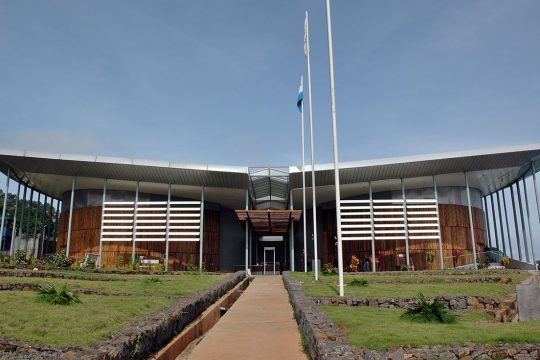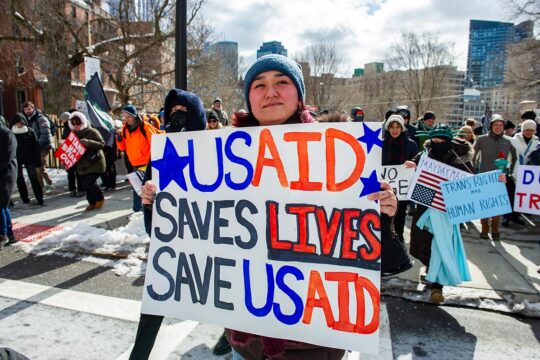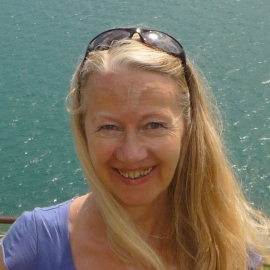Context: Sierra Leone’s Civil War (1991-2002)
Sierra Leone’s civil war broke out in 1991 when RUF rebels captured towns on the border with Liberia, and was to last for eleven years, leaving tens of thousands dead and many more maimed and displaced. It was marked by appalling abuses, especially against civilians. “As the conflict exploded into appalling brutality against civilians, the world recoiled in horror at the tactics used by the RUF, its allies and opponents,” says the report of the country’s Truth and Reconciliation Commission. “Reports emerged of indiscriminate amputations, abductions of women and children, recruitment of children as combatants, rape, sexual slavery, cannibalism, gratuitous killings and wanton destruction of villages and towns.” The war was fuelled by the country’s rich diamond resources, also coveted by Charles Taylor in neighboring Liberia. The ex-Liberian president was later convicted by the Special Court for Sierra Leone for “aiding and abetting” crimes committed by the rebels, and participating in their planning.
In 1991, Foday Sankoh’s RUF began a campaign against President Joseph Momoh, capturing towns on the border with Liberia. In 1992, Momoh was ousted in a military coup led by Captain Valentine Strasser. Under international pressure, he announced plans for multi-party elections. As the war continued, Strasser was also ousted in a coup in January 1996, led by Brigadier Julius Maada Bio. In February the same year, Ahmed Tejan Kabbah was elected president and in November signed a peace deal (the Abidjan Peace Accord) with the rebels. But the peace deal unraveled the following year and Kabbah was ousted by a military junta (the Armed Forces Revolutionary Council, AFRC) led by Major Johnny Paul Koroma. The RUF joined with the AFRC.
The UN imposed sanctions on Sierra Leone and in early 1998 a Nigerian-led West African intervention force (Ecomog) stormed Freetown, driving out the military junta. Kabbah made a triumphant return, to scenes of public rejoicing. But in January 1999, the RUF seized parts of Freetown from Ecomog. After weeks of fighting they were driven out, leaving some 5,000 dead and a city in ruins. World leaders intervened diplomatically to promote negotiations between the RUF and the government, and in July 1999 the Lomé Peace Accord was signed. Under the peace deal, the RUF received posts in government and assurances they would not be prosecuted. UN peacekeepers began arriving to police the peace deal, but by May 2000 the rebels were again advancing on Freetown. Britain sent 800 paratroopers to Freetown to evacuate British citizens and help secure the airport for UN peacekeepers. Rebel leader Foday Sankoh was captured. However, worse was to come: the RUF besieged two companies of UN peacekeepers in their compound for 75 days, while in August, eleven British soldiers were taken hostage by a renegade militia called the “West Side Boys”. The hostages were only freed after international military operations. The war was finally ended by a strong armed international intervention, including élite British troops. On January 18, 2002, President Kabbah declared the Sierra Leone civil war over.
Transitional Justice Mechanisms
Special Court for Sierra Leone (SCSL) – 2002 to 2013
The SCSL was established under a 2002 agreement between the United Nations and the government of Sierra Leone, after national authorities invited the UN to establish a hybrid (mixed international and national) tribunal in the country to address serious crimes against civilians and UN peacekeepers committed during the country's civil war. The Court started its first trial in 2004, and in 2013 became the first international criminal court to close, after a final judgment in the case of former Liberian leader Charles Taylor.
Its mandate was to try those "bearing the greatest responsibility" for crimes committed in Sierra Leone after November 30, 1996, the date of the failed Abidjan Peace Accord. The Court had a mandate to try crimes against humanity (including murder, imprisonment, torture, rape and other crimes) and other serious violations of international humanitarian law. Its mandate also gave it the possibility to prosecute perpetrators for certain crimes under Sierra Leonean laws relating to the abuse of young girls, the conscription of children into the army and the wanton destruction of property.
The people tried: Leaders and commanders of the RUF (Revolutionary United Front), AFRC (Armed Forces Revolutionary Council) and CDF (Civil Defence Forces, pro- the Kabbah government), plus Liberian former president Charles Taylor.
Results: Ten persons were brought to trial. Two other accused persons died: RUF leader Foday Sankoh, who died in detention on July 29, 2003 before being brought to trial, and RUF Battlefield Commander Sam Bockarie, who was allegedly killed in Liberia. A third prime suspect, (AFRC Chairman Johnny Paul Koroma), fled Sierra Leone shortly before he was indicted, and is said to be dead, although this has not been confirmed. One person (CDF leader Samuel Hinga Norman) died while awaiting judgment, and proceedings against him were terminated.
Nine people were convicted and sentenced to terms of imprisonment ranging from 15 to 52 years. The eight RUF, CDF and AFRC prisoners convicted in Freetown are serving their sentences in Rwanda. Taylor, who was tried in The Hague for security reasons (under an agreement with the International Criminal Court), is serving his 50-year jail sentence in the UK.
Truth and Reconciliation Commission (TRC) - 2002 to 2004
Sierra Leone’s Truth and Reconciliation Commission (TRC) was part of the 1999 Lomé peace accord between the government and the RUF, but only became operational in 2002. Its mandate was to “create an impartial historical record of violations of human rights and international humanitarian law related to the armed conflict in Sierra Leone from the beginning of the Conflict in 1991 to the signing of the Lomé Peace Agreement; to address impunity; to respond to the needs of victims; to promote healing and reconciliation; and to prevent a repetition of the violations and abuses suffered”.
The TRC was composed of seven members, four of whom were Sierra Leonean and the rest internationals.
Results: The Commission gathered 7,706 statements, held countrywide public hearings and submitted an extensive final report to the Sierra Leone government in October 2004. The report’s recommendations included reparations to victims; reform of the judiciary and security services; and measures to promote human rights, good governance and freedom of expression. However, although Sierra Leone has had democratically elected governments since the war, successive governments have been slow to follow up on the recommendations.






